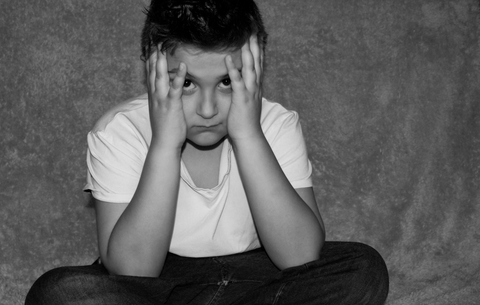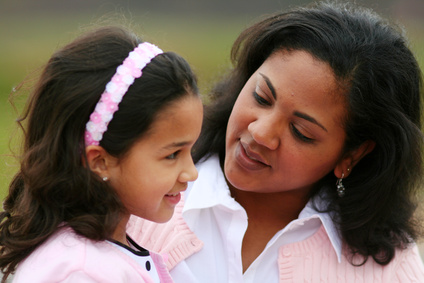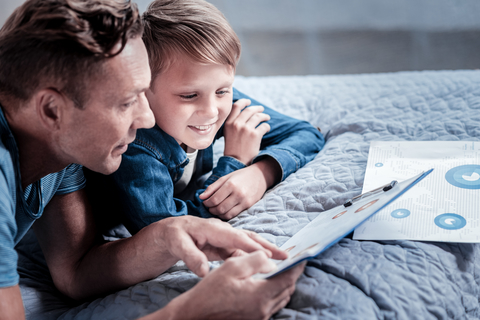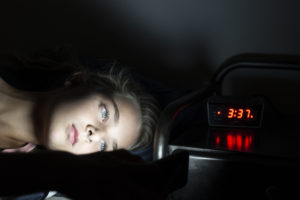Monsters? Creepy noises? Frequent insomnia? Many children with and without ADHD struggle with going to bed, being in a dark room and falling asleep. Of course, it’s normal to be frightened of unfamiliar things. it’s also common for some kids with ADHD to struggle to turn off their brains even though their bodies are tired. For kids with ADHD, who struggle to manage strong emotions and can over-focus on particular thoughts, night-time fears can be especially problematic. Instead of you falling asleep in their bed or endlessly reassuring them, change your approach to one that creates confidence and happy slumber for everyone. Become their ally and take on the night dragons once and for all.  Most kids tend to stay away from the stuff that scares them. Who doesn’t? Anxiety is a powerful force to contend with. If they’re not exposed to it, then they’re not afraid. But avoidance and depending completely on you for comfort may feel good now but doesn’t help them in the long run. They don’t learn essential skills for self-soothing and positive self-talk. People build courage by being afraid and doing it anyway. Comfort is important to give but it can’t be the only solution.
Most kids tend to stay away from the stuff that scares them. Who doesn’t? Anxiety is a powerful force to contend with. If they’re not exposed to it, then they’re not afraid. But avoidance and depending completely on you for comfort may feel good now but doesn’t help them in the long run. They don’t learn essential skills for self-soothing and positive self-talk. People build courage by being afraid and doing it anyway. Comfort is important to give but it can’t be the only solution.  Learning to tolerate discomfort in the dark takes time. You will probably have to proceed slowly at first. Set up a plan by talking with your son or daughter about what frightens them, when they’ve managed to overcome that fear and how they did it. You want to identify successful nights and what made them work. Your child wants this to go away and so do you: that’s your mutual motivation for creating a collaborative plan. The goal is to strengthen the side of them that wants to do it and make it bigger than the part that doesn’t. Use incentives with your plan such as points towards an activity they like (playing a game with you, additional screen time, etc.).
Learning to tolerate discomfort in the dark takes time. You will probably have to proceed slowly at first. Set up a plan by talking with your son or daughter about what frightens them, when they’ve managed to overcome that fear and how they did it. You want to identify successful nights and what made them work. Your child wants this to go away and so do you: that’s your mutual motivation for creating a collaborative plan. The goal is to strengthen the side of them that wants to do it and make it bigger than the part that doesn’t. Use incentives with your plan such as points towards an activity they like (playing a game with you, additional screen time, etc.).  This may sound crazy but let’s take riding a roller coaster. Instead of going on the biggest one or even the medium-sized one, you start with something small to build your confidence. Then if that goes well, you can try a larger one. Similarly, leaving your child alone in the dark may be too much right now. Make a game to check the closet and under the bed for unwanted “guests.” When it’s time to turn out the light, turn on a night light, keep the door open, maybe play some soothing music and leave a light on in the hallway. Limit your time hanging out with them to ten minutes and discuss this well before bedtime. Maybe you’ll need to sit in a chair at first, then by the door while humming a favorite tune. When they’re doing a better job of managing the separation and falling asleep on their own, consider closing the door halfway. Maybe that’s enough. At some point, perhaps you can close the door completely and if you can’t that’s okay too. The goal is to start doing small changes, let them feel successful and then tackle the bigger stuff.
This may sound crazy but let’s take riding a roller coaster. Instead of going on the biggest one or even the medium-sized one, you start with something small to build your confidence. Then if that goes well, you can try a larger one. Similarly, leaving your child alone in the dark may be too much right now. Make a game to check the closet and under the bed for unwanted “guests.” When it’s time to turn out the light, turn on a night light, keep the door open, maybe play some soothing music and leave a light on in the hallway. Limit your time hanging out with them to ten minutes and discuss this well before bedtime. Maybe you’ll need to sit in a chair at first, then by the door while humming a favorite tune. When they’re doing a better job of managing the separation and falling asleep on their own, consider closing the door halfway. Maybe that’s enough. At some point, perhaps you can close the door completely and if you can’t that’s okay too. The goal is to start doing small changes, let them feel successful and then tackle the bigger stuff.  Be patient. Reducing night-time worries takes time, practice and some stumbling along the way. Stick with the plan you’ve both created for a few days, assess how it’s working together, and make any necessary adjustments. Let your child’s desire to do things differently guide you. Courage will naturally follow.
Be patient. Reducing night-time worries takes time, practice and some stumbling along the way. Stick with the plan you’ve both created for a few days, assess how it’s working together, and make any necessary adjustments. Let your child’s desire to do things differently guide you. Courage will naturally follow.
Category: Anxiety, Depression & More
Why Do I Cry So Easily? Experts Break Down the Reasons Behind Your Tears
One37pm: The Worrier’s Guide to Success
Helping Kids with ADHD get more ZZZZ’s
If your son or daughter has trouble going to sleep, you are not alone. There are several issues that complicate going to sleep for kids with ADHD. Some kids are sensitive to the medication they take and it can negatively impact their ability to drift into slumber. If they take a booster after-school to help with doing homework, this can be especially true. Perhaps your child is not be that physically tired. Vigorous, regular exercise could help them nod off more easily. Many kids today (those with and without ADHD) also tend to spend too much time on their screens too close to bedtime. Most physicians (and many sleep studies) recommend turning off screens at least one hour prior to bed. If you have an teen in your midst, the onset of adolescence and its hormonal and psychological changes can further prevent getting some good shut-eye.  Here are a few steps that you can take to help your child or teen get a good night’s rest: Start with making an appointment with whoever prescribes his medication. It’s very important that they know what is going on so they can make any appropriate changes or suggestions about his sleep challenges. Reflect on your family’s evening routine. Is there adequate time built-in for chilling out before turning off the light? What have you (or your partner) observed that has helped your son or daughter in the past? Jot down these ideas. In a calm moment, perhaps after dinner, talk with your child or teen about the issue of going to sleep. The goal is to collaborate on sleep solutions, not get into a blame game or an argument. If you find yourself getting agitated or they starts to become defensive, pause and take some deep breaths together. Begin by asking about falling asleep. Is he tired? Is she frustrated? What would they like to see that’s different from what’s going on now? Talk about why you also want a better routine.
Here are a few steps that you can take to help your child or teen get a good night’s rest: Start with making an appointment with whoever prescribes his medication. It’s very important that they know what is going on so they can make any appropriate changes or suggestions about his sleep challenges. Reflect on your family’s evening routine. Is there adequate time built-in for chilling out before turning off the light? What have you (or your partner) observed that has helped your son or daughter in the past? Jot down these ideas. In a calm moment, perhaps after dinner, talk with your child or teen about the issue of going to sleep. The goal is to collaborate on sleep solutions, not get into a blame game or an argument. If you find yourself getting agitated or they starts to become defensive, pause and take some deep breaths together. Begin by asking about falling asleep. Is he tired? Is she frustrated? What would they like to see that’s different from what’s going on now? Talk about why you also want a better routine.  Discuss the skill of self-regulation–the ability for kids with ADHD to manage themselves–and how it relates to sleep challenges. What do they notice on those nights when sleep comes easily? What is or isn’t happening at those times compared to the nights when it’s tougher? Review the nightly routine and share your observations too. Should you replace pre-sleep stimulation like playing computer games, using social media or surfing the net with quieter brain activities? If they report worrying a lot before bed, consider seeking counseling. Brainstorm ways to create a routine that integrates what has helped them in the past with what could be useful now. Just like you’ve developed ways to get yourself to sleep, your child or teen needs to learn this same skill. Set up a new plan for the hour before bed. Listening to music, riding a stationary bike, watching a regular TV show or working on a big puzzle or fun project with a parent can all be good substitutions for computer games and social media time. Once they are under the covers, if they are willing to read anything–the sports page, a graphic novel or a mystery, establish an endpoint for that. If reading is not an option, maybe listening aloud to a podcast, an audio book, a relaxation exercise or quiet music could work. Be clear and specific.
Discuss the skill of self-regulation–the ability for kids with ADHD to manage themselves–and how it relates to sleep challenges. What do they notice on those nights when sleep comes easily? What is or isn’t happening at those times compared to the nights when it’s tougher? Review the nightly routine and share your observations too. Should you replace pre-sleep stimulation like playing computer games, using social media or surfing the net with quieter brain activities? If they report worrying a lot before bed, consider seeking counseling. Brainstorm ways to create a routine that integrates what has helped them in the past with what could be useful now. Just like you’ve developed ways to get yourself to sleep, your child or teen needs to learn this same skill. Set up a new plan for the hour before bed. Listening to music, riding a stationary bike, watching a regular TV show or working on a big puzzle or fun project with a parent can all be good substitutions for computer games and social media time. Once they are under the covers, if they are willing to read anything–the sports page, a graphic novel or a mystery, establish an endpoint for that. If reading is not an option, maybe listening aloud to a podcast, an audio book, a relaxation exercise or quiet music could work. Be clear and specific.  The time before sleep is often when kids want to chat about their lives. They seem more open to confide in you and ask for your advice. Prop your own eyelids open and to sit down for a few minutes. The connection will be worth it!
The time before sleep is often when kids want to chat about their lives. They seem more open to confide in you and ask for your advice. Prop your own eyelids open and to sit down for a few minutes. The connection will be worth it!
TADD 2018- Overcoming anxiety so you live more confidently
ADHD Support Talk Radio: Turning down the Volume on Anxiety with Adult ADHD
The Bright and Quirky Child Summit: Fostering Resilience for Kids with Anxiety
Attention Magazine: Worried & Preoccupied-Five Ways You Can Reduce Anxiety and Live More Confidently
AttentionTalk Radio: ADHD Tips– The Relationship Between Worry and Anxiety
AttentionTalk Radio: ADHD Tips– The Relationship Between Worry and Anxiety







